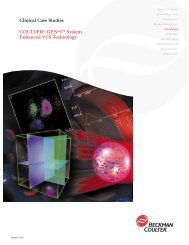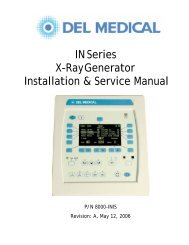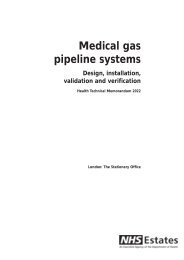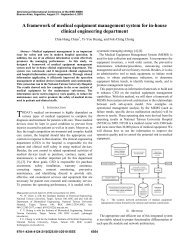Electrosurgery Self-Study Guide
Electrosurgery Self-Study Guide
Electrosurgery Self-Study Guide
You also want an ePaper? Increase the reach of your titles
YUMPU automatically turns print PDFs into web optimized ePapers that Google loves.
<strong>Electrosurgery</strong> <strong>Self</strong>-<strong>Study</strong> <strong>Guide</strong><br />
Voltage<br />
Voltage is the force that will cause one amp to flow<br />
through one ohm of resistance. It is measured in volts.<br />
The voltage in an electrosurgical generator provides the<br />
electromotive force that pushes electrons through the<br />
circuit.<br />
Power<br />
Power is the energy produced. The energy is measured in<br />
watts. In electrosurgical generators the power setting<br />
used by the surgeon is either displayed on an LED screen<br />
in watts; or, a percentage of the total wattage as indicated<br />
on a numerical dial setting (Lister, 1984).<br />
Principles of<br />
<strong>Electrosurgery</strong><br />
Electrocautery<br />
The electrocautery device is the simplest electrical<br />
system used in the operating room today. It uses battery<br />
power to generate a simple direct current (DC). The<br />
current never leaves the instrument to travel through the<br />
patient’s tissue. An example is the small hand-held eye<br />
cautery (Figure 1). The battery heats up a wire loop at the<br />
end of the device. The cautery is useful in ophthalmic<br />
surgery and other very minor procedures in which very<br />
little bleeding is encountered. Its use is limited because it<br />
cannot cut tissue or coagulate large bleeders. It is further<br />
limited because the target tissue tends to stick to the<br />
electrode.<br />
The term “electrocautery,” or “cautery,” is often, and<br />
incorrectly, used to describe all types of electrosurgical<br />
devices. Its use is only appropriate to describe the simple<br />
direct current cautery device.<br />
Figure 1 – Electrocautery<br />
6<br />
<strong>Electrosurgery</strong> and Radio Frequency<br />
Current<br />
A frequently asked question is why electrosurgery<br />
generators do not shock patients. The answer is because<br />
of the higher frequencies at which generators operate.<br />
Radio frequency current alternates so rapidly that cells do<br />
not react to this current. AM radio stations operate in the<br />
550 to 1500 KiloHertz (kHz) range. <strong>Electrosurgery</strong><br />
generators operate in the 200 kHz to 3.3 megahertz<br />
(MHz) range (Figure 2). Both of these are well above the<br />
range where neuromuscular stimulation or electrocution<br />
could occur (Harris, 1978).<br />
60 Hz 100 kHz 550 - 1550 kHz 54 - 880 M<br />
Household<br />
Appliances<br />
Muscle and Nerve<br />
Stimulation Ceases<br />
<strong>Electrosurgery</strong><br />
Figure 2 – Frequency Spectrum<br />
200 kHz - 3.3 MHz<br />
AM Radio TV










